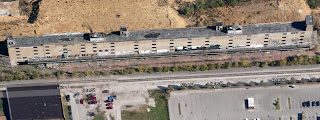In an earlier post, I pointed out that the focus on abandonment in the various Afterdays Media endeavors is not simply about emptiness, but how abandonment can be instructive. Here is another example...
An
empty lot in the city is so utterly mute of the millions of stories and
memories that hinged upon the buildings that once stood there. One sees only
vacancy, and can barely imagine the former presence of structures, landscapes,
or people. And in many places, what was recently removed was not the first to
occupy the site. Often, there were generations of structures that were built,
inhabited, and demolished on the same, small parcel of ground. Layers of
places, and so many more layers of lives, activities, and stories. Historians
try to tell us this all of the time.
Take
for instance the 600 block of West Monroe Street in Springfield, Illinois.
Along the north side of the street, a completely unremarkable block has been
erased of its buildings, landscaping, lot lines, and even its addresses. Today
it just looks bad, but probably not as bad as a row of abandoned or
disintegrating structures that “blighted” the properties a decade or more ago,
depressing the neighbors and their property values.
I
stumbled across a little reminder of the invisible iceberg of such stories,
melting away along most of our city streets. The reminder was in the form of an
advertisement in a 1970 phonebook. A small business (probably a very small
business ) that came and went over 40 years ago. Earth Sounds: rock albums and far-out clothing. Earth Wears.
This
was probably a small shop tacked together in an aging brick storefront, or
perhaps in a converted wood-frame residence. No one remembers. Imagine the
décor, the products, or the sound of a little window air conditioner droning
away in the summer heat of 1970. Jimi and Janis, and that Iron Butterfly record
that someone’s sister had. Incense, macramé, black light posters, and maybe
some paraphernalia behind the counter. Things For Your Head. Promising an alternative lifestyle, encouraging a
return to nature, and helping you look cool - all at the same time.
Imagine
the conversations, and the plans of the twenty or thirty-somethings that ran
the place. See the purchases made by their too-occasional customers, who came
inside to reaffirm their membership in what was a rapidly fading
counterculture. Things were changing.
Earth Sounds was probably just a brief, homespun, Midwestern echo of the massive
cultural party that was happening on the West Coast. Politics, cobbled-together
belief systems, and always pop culture. An outpost and a dream. It is
remarkable how thoroughly such things can be erased from our landscapes.
UPDATE! Earth Sounds remembered. Click HERE








































